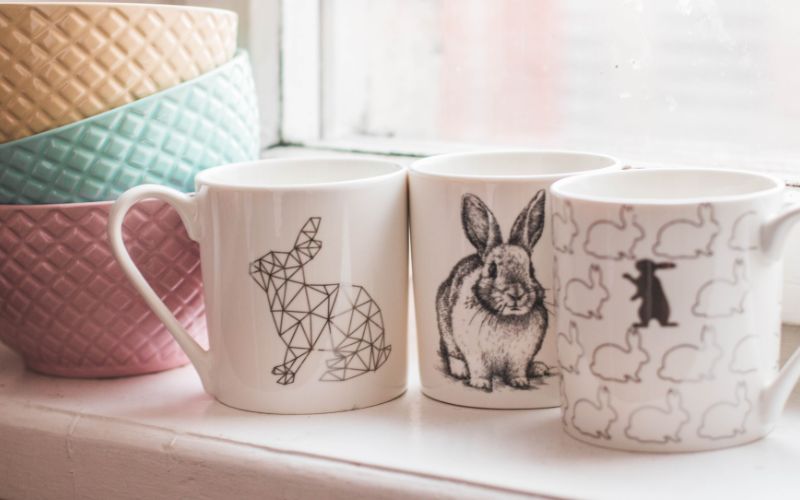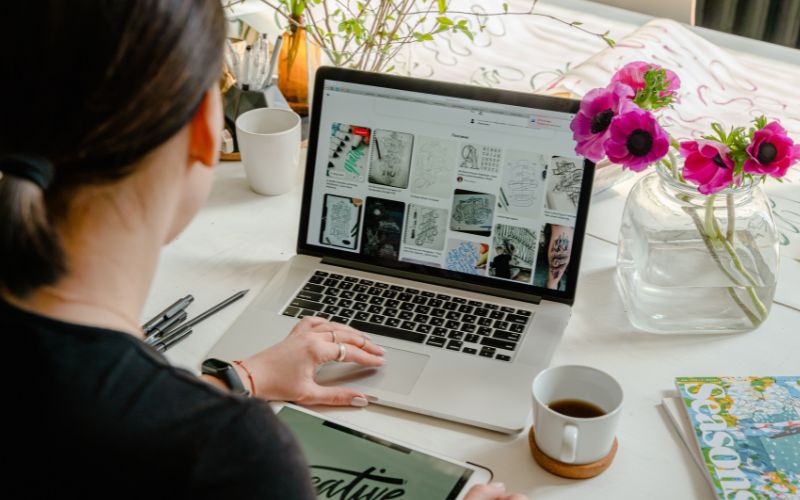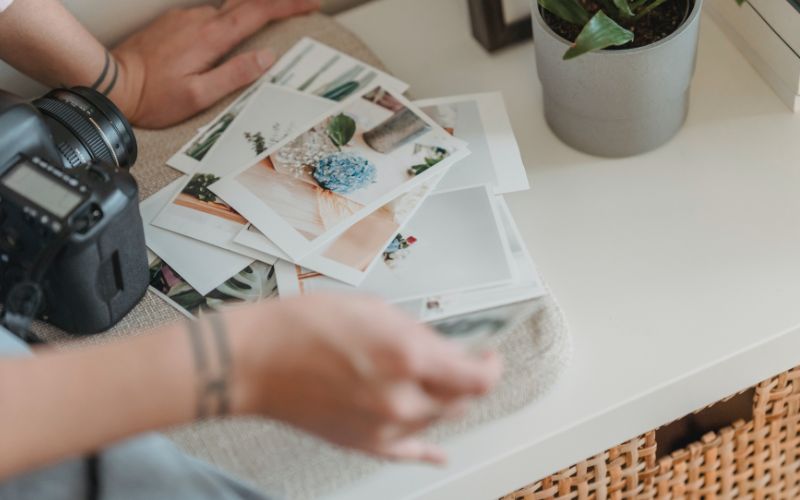How to license your artwork: a beginners guide to artwork licensing
Luke Martin | 18th April 2023

No matter what kind of artist you are, learning about artwork licensing is a valuable skill that will help you build your art-related income.
As an artist, you want to spend as much time as possible creating a portfolio of work, exploring new artistic ideas, and immersing yourself in your art. It’s just what we love to do.
Licensing allows you to do just that: monetizing your body of work to someone else who will use that artwork in commercial products from calendars to clothing to homeware and gifts in exchange for a fee.
The rewards for artwork licensing can be transformative, so let’s take a closer look at how to get started.
This article will cover the 13 most common questions about artwork licensing:
1. What is artwork licensing?
2. What does it mean to license artwork?
3. How do I get royalties for my artwork?
4. How much money can I make licensing my artwork?
5. What type of artwork is suitable for licensing?
6. How do I protect my artwork?
7. How do I build relationships with the licensing industry?
8. What does an artwork licensing agent do?
9. Am I ready to license my artwork?
10. What is an artwork licensing agreement?
11. Common artwork licensing term definitions
12. What is an artwork licensing trade show?
13. What are the alternatives to artwork licensing?
1. What is artwork licensing?
Artwork licensing is when an artist signs a contract (also known as a licensing agreement) to allow another person or company to use their artwork for commercial purposes in exchange for a fee.
This fee can be a one-off payment or an ongoing percentage of sales, it all depends on the terms you negotiate.
Artwork licensing can provide you with an ongoing passive income, and comes with none of the headaches involved in manufacturing and marketing a product range of your own.
As an artist, you own the copyright to the work you produce. Licensing allows you to make money from those artworks without giving up that copyright or losing control of how other people use your work.
You can do this in lots of different ways. From a single-use license for a one-time event to ongoing agreements with manufacturers making multiple production runs. There is no one size fits all licensing deal, there are lots of ways to make licensing work for you.
There are three ways artists usually find artwork licensing deals:
- You are approached by a company and offered a deal
- You find an agent who represents you and your work, who finds you deals.
- You approach companies and pitch your artwork for licensing.
Lots of artists do one or a combination of these, depending on the terms of each contract.
2. What does it mean to license artwork?
Licensing artwork means to pay an artist a fee in exchange for using their artwork for commercial purposes. Companies often do this when they are looking for interesting, high-quality artwork for their products and packaging.
3. How do I get royalties for my artwork?
To get royalties for your artwork, license your images to people who need artwork for their products and in return, you can earn a fee. This is called artwork licensing. Alternatively, upload your artwork to products on print-on-demand websites such as Printful or Red Bubble, and receive a royalty based on a percentage of each sale made.
4. How much money can I make licensing my artwork?
The money you receive from licensing your artwork is known as royalties. The exact amount you can make in royalties depends entirely on the deals you (or your agent) can negotiate.
According to the Graphic Artists Guild, typical royalties for artwork licensing are between 3-10% of revenues, with the rate rising to 15% for brand and character licensing. A mass-market chain might offer you royalties as low as 3-5%, however, they are likely to bring in a much greater volume of sales than a smaller operator.
Royalties are normally paid quarterly (every 3 months). Remember, if you are working with a manufacturer, the royalties will likely be based on wholesale prices, not retail.
Sometimes an advance payment is made to the artist in addition to the ongoing royalty percentage, at the start of an agreement, as a sign of good faith and expected sales.
A typical advance payment might be 5-10% of total expected royalties over the life of the license agreement. However, this is becoming a less common practice for all but the most in-demand artists.
5. What type of artwork is suitable for licensing?
Most companies that are seeking to license artwork are looking for something to use across a product range, comprising variations on a theme.
Popular products for artwork and illustration licensing include ceramics, gifts and greetings cards, tea towels and homeware, puzzles, toys, stationery, fabrics, and wallpaper.

To some artists, this will be a natural fit, but others will need to adopt a commercial mindset and create work that can easily work with the needs of your licensee.
This typically means creating work as a series, and in sets that can easily translate to a full product range, rather than individual, one-off pieces.
Some applications such as wallpaper, stationery and fabric printing require pattern artwork with a repeat, rather than a one-off piece, making them an attractive niche for printmakers and graphic artists.
There is no limitation on the medium you use for licensed artwork, but you will require high-resolution scanned (or very well photographed) images for the licensee to use.
Most companies will be looking for artwork that fits their particular niche really well and is up to date with the latest trends.
Make sure you’re well aware of what’s going on in the market and where your particular style of artwork will fit into that mix.
Don’t randomly approach potential licensees without first understanding the type of artwork they are looking for.
6. How do I protect my artwork?

If you are going to start putting your work out there for commercial use, you want to ensure that you will reap the benefits of that use.
Whilst all artwork is automatically protected by copyright when you create it, it is much easier to enforce that protection if you have registered your copyright with the government in your country. This will prove that you created the artwork on a certain date, showing and describing exactly what designs you have registered and when.
Copyright or design registration can be a requirement of some licensing agreements too, as a warrant to the licensee that you do in fact own the artwork they are licensing.
7. How do I build relationships with the licensing industry?
You’ll hear this a lot as an artist, but networking and relationship building are really important if you want to break into the world of artwork licensing.
Cold calling random companies and aggressive sales pitches are only going to alienate potential licensees. However, approaching companies who are a natural fit for your style of art is a good strategy for artists who want to go it alone without an agent.
Start to build a name for yourself as an artist (through a website, public relations, social media, and exhibiting), and start building relationships with the decision-makers, brands, and trendsetters for the niche you have selected.
Communication and sales skills are essential, if you can speak to people in an authentic and personable way, you will increase your chance of success.
Managing your professional relationships can be challenging, but the key is to be super organized and keep track of all of your interactions.
Creating an email database of contacts is a great way to keep everybody updated on your latest creations in a succinct and easy-to-digest bulletin.
Use email marketing services such as MailChimp or Sendfox to manage your email list and send bulk emails.
8. What does an artwork licensing agent do?

You might decide you would prefer to team up with an experienced art licensing agent to license your artwork.
Art licensing agents tend to specialize and have existing clients for specific niches, such as fabrics or giftware.
Some agents will represent a handful of artists and some may represent hundreds of artists, it all depends on the agency.
An agent will take a cut of your royalties, and in exchange will take care of the licensing for you. Typically this could be 30-50% of gross licensing royalties, but may also require you to pay other associated costs and fees.
A note on working with agents: always seek legal advice before signing a contract and be sure of what your obligations and liabilities will be under any contract you sign. It’s important to understand what each agent is offering, as services vary enormously.
Finding an agent to represent you isn’t always easy, and you might face a lot of rejection before someone says yes.
Some well-known art licensing agents include:
- https://wildapple.com/
- https://www.pinklightstudio.com/
- https://www.mosaiclicensing.com/
- https://roaringbrookart.com/
- http://www.cypressfineart.com/index.html
Do you need an agent to license your artwork?
The short answer is no. There is nothing stopping you from reaching out and making your own licensing deals with companies. However, some agents will already have powerful industry contacts and can open doors that you might find difficult to open yourself.
9. Am I ready to license my artwork?

Whilst there are no set rules on how to do licensing, but, there are things you can do to give yourself the best chance for success.
Ask yourself the following questions to see if you are ready:
- Do you have a portfolio of 50-100 pieces of original work?
- Do you have high-resolution images of all of your work?
- Are you able to work to a tight deadline and make changes if needed?
- Do you have a clear understanding of what licensees are looking for from you as an artist?
- Do you understand the terms that are likely to be included in your contract?
- Do you have a pitch prepared to present your artwork to buyers in a clear and professional way?
- Do you understand who your competitors are and how your work fits into the market?
- Do you have a thick skin? You must get used to handling rejection on a regular basis.
Preparation is key, if you want to be successful at licensing you need to be ready to move quickly and professionally.
Putting together a presentation to show to potential licensees is the best way to show what you do. Include clear, high-resolution images of your work and mock-ups demonstrating how your artwork looks on relevant products.
A company might look at tens of thousands of potential images per year, so yours needs to stand out and communicate the information they are looking for.
10. What is an artwork licensing agreement?
Every art licensing deal is backed up by an agreement signed by the artist and the licensee, describing the terms of the licensing deal.
This is a legal contract, so it’s important to understand what it contains.
If you don’t clearly agree on the terms of a deal in advance, you are likely to encounter problems later on.
It is very important that each party has the same expectations of the arrangement you are making.
This not only protects you and your intellectual property, but it is also what gives the licensee a commercial opportunity and therefore a reason to pay you.
Most art licensing agreements will specify the following points as part of the agreement:
- Name and define each party involved in the deal.
- The duration (term) of the agreement.
- The specific products your artwork will be used on.
- Any other intended uses for the artwork (social media, online, marketing etc).
- The geographical locations that are covered by the agreement.
- The royalty structure including any advanced payments.
- The payment schedule and method.
- Schedule of reports and communications
- Exit and dispute terms if there are problems or changes in circumstance.
- Any exclusivity terms you agree on.
It is worth having a qualified lawyer take a look at any licensing agreement you are asked to sign. If you are creating your own licensing agreement, it is also worth having your agreement professionally reviewed before signing it.
11. Common artwork licensing terms & definitions
Advance: A non-refundable payment made to the artist when a license agreement is signed.
Exclusive: Some licensees will demand exclusive use of an artwork, meaning you cannot license it to anybody else for the term of the agreement. If you are licensing an artwork to multiple different licensees at the same time, you would need a non-exclusive license agreement.
Perpetual License: A royalty payment is made once upfront, after which the licensee can use your artwork in perpetuity.
Limited License to Use: This is where you stipulate any limitations of the use of your artwork.
Scope: What does the license agreement cover? Typically this refers to field of use, geography, time and exclusivity rights.
Geography: This defines the geographical region that the license covers.
Time: Some licenses carry an expiration date or clearly defined time period at which the license ends or can be renewed. How you define time can affect how you chose to price your license (annual renewal fee or ongoing?)
Representations & Warranties: This is your promise to the licensee that the artwork is yours to license out and that it doesn’t infringe on anybody else’s intellectual property. It can be sensible to limit the scope of your warranty to copyright protections you have already granted, as these are most enforceable.
Indemnification: This is the promise that if you break any of your representations and warranties that you will cover the costs to cover any damages.
Limitations on Liability: The limit you will be required to pay as a licensor in the event any claim is made on your warranties. Typically you will cap this at the value of the license agreement, though licensees will ask for more.
Most favored Nations: One to avoid if possible. This means that if you ever offer a new licensee better terms you must go back and then offer those same terms to your other licensees.
Jurisdiction and Venue: This determines the legal jurisdiction your license agreement is written under, and therefore would be disputed under in the case of a legal battle.
Attorney Fees: If you do find yourself in a legal dispute, this determines who will pay the legal fees.
12. What is an artwork licensing trade show?
Trade shows have been a regular part of the art licensing calendar for years. Trade shows are an opportunity to meet industry decision-makers, agents, exhibit your work and stay ahead of trends.
It isn’t essential to attend trade shows, but they do form an important part of the design cycle for many companies, and buying decisions are often made according to specific seasonal dates.
Here are some of the biggest artwork licensing trade shows:
- https://www.americasmart.com/
- http://www.surtex.com/
- http://craftandhobby.org/
- http://www.licensingexpo.com/
- http://www.printsourcenewyork.com/
- https://nynow.com/
- https://artlicensingshow.com/
Trade shows can be helpful for lots of reasons, even if you only attend as a visitor.
- Meet industry players, decision-makers and brands interested in licensing artwork.
- Discover art licensing agents who could represent you and your work.
- Attend talks and seminars to help you learn more about the industry
- Meet the press and take part in interviews, vox pops and PR opportunities.
- Meet other artists and find inspiration.
13. What are the alternatives to artwork licensing?

Art licensing is not for everyone, so if you aren’t ready to dive into licensing there are still ways you can proceed to start monetizing your portfolio of work.
Print-on-demand websites are the easiest place to get started if you want to see your artwork on a range of products.
Websites such as Printful or Printify allow you to upload your artwork as a digital file and put it on a whole range of products from homeware to clothing. You can then list these items in your online store or on social media, and the company will print and send them to your customer if they sell.
The benefit of using a print-on-demand partner is that you don’t need to hold any stock or make items in advance, you only pay when you make a sale and they take care of all of the fulfillment.
Alternatively, you can create your own products based on your artworks by getting crafty.
Prints are a great place to start, but you can go one step further and turn paintings or drawings into themed collections. This is a great chance to try new materials and mediums to take your artwork to new levels.
If you are a photographer, you might consider licensing your work to an art publisher. Most art publishers will require exclusivity, but they will use their network to sell your work as posters, calendars, prints, puzzles and other wall décor items.
The only limit is your imagination, and there are many ways to monetize your art beyond artwork licensing.
Conclusion
Hopefully, this will have given you a good insight into the world of artwork licensing and inspired you to consider it for yourself.
This is just an introduction to what can seem like a daunting and complicated world.
However, remember the basics and you won’t go too far wrong. Protect your work, control its use and back everything up with paperwork.
Art licensing is a lucrative revenue stream for many artists, and it leaves you free to do what you do best, create artworks.
